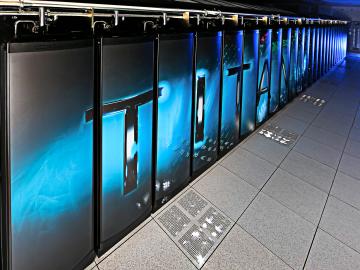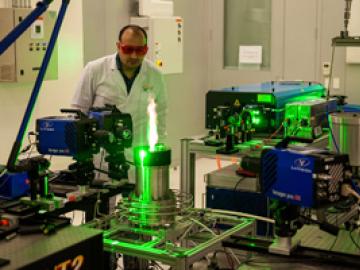
Filter News
Area of Research
- (-) Fusion Energy (7)
- (-) Supercomputing (172)
- Advanced Manufacturing (7)
- Biological Systems (3)
- Biology and Environment (119)
- Biology and Soft Matter (4)
- Building Technologies (3)
- Chemical and Engineering Materials (3)
- Chemistry and Physics at Interfaces (7)
- Clean Energy (208)
- Climate and Environmental Systems (7)
- Computational Biology (1)
- Computational Chemistry (5)
- Computational Engineering (2)
- Computer Science (4)
- Data (1)
- Earth Sciences (1)
- Electricity and Smart Grid (2)
- Energy Frontier Research Centers (7)
- Energy Sciences (2)
- Fuel Cycle Science and Technology (2)
- Functional Materials for Energy (10)
- Fusion and Fission (43)
- Geographic Information Science and Technology (1)
- Isotopes (24)
- Materials (186)
- Materials Characterization (2)
- Materials for Computing (17)
- Materials Synthesis from Atoms to Systems (8)
- Materials Under Extremes (8)
- National Security (54)
- Neutron Data Analysis and Visualization (2)
- Neutron Science (83)
- Nuclear Science and Technology (35)
- Quantum Condensed Matter (3)
- Quantum information Science (5)
- Renewable Energy (2)
- Sensors and Controls (2)
- Transportation Systems (6)
News Type
News Topics
- 3-D Printing/Advanced Manufacturing (4)
- Artificial Intelligence (24)
- Big Data (14)
- Bioenergy (4)
- Biology (7)
- Biomedical (8)
- Biotechnology (1)
- Buildings (3)
- Chemical Sciences (2)
- Climate Change (13)
- Computer Science (52)
- Coronavirus (8)
- Cybersecurity (4)
- Decarbonization (4)
- Energy Storage (4)
- Environment (14)
- Exascale Computing (14)
- Frontier (16)
- Fusion (5)
- Grid (2)
- High-Performance Computing (26)
- Isotopes (1)
- Machine Learning (9)
- Materials (10)
- Materials Science (11)
- Mathematics (1)
- Microscopy (3)
- Molten Salt (1)
- Nanotechnology (7)
- National Security (4)
- Net Zero (1)
- Neutron Science (7)
- Nuclear Energy (6)
- Physics (4)
- Quantum Computing (11)
- Quantum Science (11)
- Security (2)
- Simulation (12)
- Software (1)
- Space Exploration (2)
- Summit (22)
- Sustainable Energy (7)
- Transportation (4)
Media Contacts


The Department of Energy’s Oak Ridge National Laboratory, FCA US LLC, and the foundry giant, Nemak of Mexico, are combining their strengths to create lightweight powertrain materials that will help the auto industry speed past the technological

Oak Ridge National Laboratory gave social media users an exclusive tour of its supercomputer Titan on Nov. 5. Using Periscope, a live video broadcasting service app, Bronson Messer, senior scientist at ORNL's Scientific Computing and Theoretical Physics Groups...

When it’s up and running, the ITER fusion reactor will be very big and very hot, with more than 800 cubic meters of hydrogen plasma reaching 170 million degrees centigrade. The systems that fuel and control it, on the other hand, will be small and very cold. Pellets of frozen gas will be shot int...








